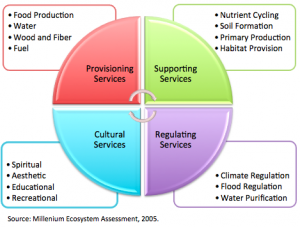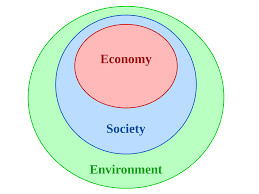It seems that the government has gone green. Having spent my working life as a teacher disagreeing with pretty much everything that Michael Gove said, I now find myself working in Environmental Science (with Gove once more my secretary of state) in the strange position of agreeing with him on multiple points. Last week the government released ‘A Green Future: Our 25 Year Plan to Improve the Environment’. Having read and reflected on this document I wanted to share my thoughts. At times I couldn’t believe what I was reading from a government that before the last election proposed a free vote on reintroducing fox hunting, dropped a pledge to ban the ivory trade from its manifesto and continues to support fracking. At other times I found myself frustrated by the grand statements, wondering if all the hopeful promises will ever see the light of day. As I reflected on the implications of this report for my project, three themes developed.
1. Natural Capital and the Ecosystem Services Approach
The Natural Capital Committee were heavily involved in the preparation of the ‘A Green Future’ and the language and concepts of Natural Capital and the Ecosystem Services approach are prominent in the plan’s text. In her foreword the Prime Minister talks about utilising our environment to ‘promote greater well-being’ (p.4). The executive summary states that the government will adopt the Natural Capital approach; ‘leading the world in using this approach as a tool in decision-making’ (p.9). Justification of this approach comes almost verbatim from the ecosystem services literature; page 19 of ‘A Green Future’ states that ‘when we give the environment its due regard as a natural asset – indeed a key contributor – to the overall economy, we will be more likely to give it the value it deserves to protect and enhance it’. Compare this with Daily et al. (2009 p.21) who explain that the vision of the ecosystem services paradigm is
“a world in which people and institutions appreciate natural systems as vital assets, recognize the central roles these assets play in supporting human well-being, and routinely incorporate their material and intangible values into decision making”
Past degradation of our landscape, the report claims, was because ‘the many benefits that the environment provides are not fully understood or measured’ (p.31). Clearly experts in the field of ecosystem service assessment were listened to during the preparation of this report. Is this a good thing or not?
Had I read ‘A Green Future’ and only seen natural capital discussed in terms of economic values I would have been hugely discouraged. If ecosystem services are discussed only in terms of their potential for supporting economic development then they lose a great deal of their power for change. But in multiple locations ‘A Green Future’ acknowledges the limitations of the the natural capital approach and highlights the intrinsic value of nature. Gove himself writes that ‘nature’s intrinsic value … is critical to our mission’ (p.6). Gove also states that our landscapes and coastlines should be valued ‘as goods in themselves’ (p.5). Aldo Leopold or Robbie Burns would skip a step to read on page 17 that ‘we should instead be recognising the intrinsic value of the wildlife and plants that are our fellow inhabitants of this planet’.
Of course economic values form an important part of the government’s plans (I doubt that governments’ approaches to conservation will ever be driven solely by moral obligation). But there is hope that economic factors will not constitute the be-all-and-end-all of decisions; the Natural Capital approach is talked about as a tool, not an absolute arbiter. I never thought I would read in a government document that ‘we do not always need to know a monetary value to know that something is worth protecting’ (p.20). Given that a central theme of my research is analysing the multiple benefits of natural capital within the Welland Catchment I find myself simultaneously encouraged by the philosophy underpinning ‘A Green Future’ and concerned that the more hopeful statements it contains will not receive the political traction required to be enacted.
2. Land Sparing, Land Sharing and Catchment Scale Measures
In the report the legislative landscape post-Brexit is framed as an opportunity to seize control of our country’s environmental management, putting the environment at the heart of policy. I’ll admit that this is the first time in two and a half years that I have felt even mildly positive about Brexit. These are grand claims and I was encouraged to see that many of the proposals put forward seem to be grounded in solid principles of landscape ecology. Gove in this instance seems not to be ‘fed up of experts‘.
One of the six policies given space in the report is ‘Using and Managing Land more Sustainably’. The plan seems to be to ‘pay farmers public money for public goods’ (p.36) in order to address the challenge of sustainable food production balanced with provision for wildlife. This sounds very much to me like a policy of direct Payment for Ecosystem Services (PES), free of some of the less desirable aspects of the Common Agricultural Policy (in my opinion) such as the Basic Payments Scheme. While there seem to be many similarities with previous agri-environment schemes (AES) such as Entry Level Stewardship and Higher Level Sewardship, I welcome the ongoing commitment to measures encouraging wildlife friendly farming. I’ll need more time to investigate the evidence base of this policy but my initial reaction is positive.
A PES policy such as the one hinted at will contribute to broad and shallow measures to conserve wildlife, ensuring that participation is high and that action is taken across landscapes. This alone would not be enough, but I was glad to read plans for creating ‘an expanding patchwork of high value habitats, as well as sympathetically managed farmland’ facilitating this through joint participation, building on work such as the farm clusters concept. The government seems to appreciate that effective land management policies will combine land sparing in the form of large, protected areas of high quality habitat joined together by a network of wildlife friendly land use options across the wider ‘working’ landscape. Designated areas for conservation are and always will be hugely important but ‘the wider environment needs to be considered too’ (p.57). The creation of a new Nature Recovery Network, committed to restoring 500,000 hectares of habitat across the country will certainly help restore some of the degradation of the past. Perhaps promising initiatives such as the Great Fen Project will now receive greater backing? However I was disappointed to see that some of the target habitats are still those highly dependent on human interaction such as meadows, grasslands and heaths (beautiful as they are). Calls for restoring natural processes across large areas of the country side and leaving nature to ‘get on with it’ still seem muted.
Framing this in the context of my research; ‘A Green Future’ will provide a useful starting point for my generation of landscape scenarios for 2050. I feel that my research questions may focus more explicitly on the various degrees to which a land sparing or land sharing approach are applied in the Welland Valley.
3. The Cultural Value of Natural Capital
Finally I was very encouraged to see the prominence given to the benefits of public engagement with nature. It seems that DEFRA’s ‘Evidence Statement on the Links Between Natural Environments and Human Health’ (2017) formed an important evidence base for these proposals. I know firsthand that getting students outside has huge benefits for their learning and happiness, so plans to make it easier for schools and Pupil Referral Units to take students on trips to natural areas (p.76) are promising, as are pledges to support schools in creating nature friendly grounds on their premises. The multiple benefits of greening urban spaces are also highlighted, alongside promises to plant 1 million more urban trees and increase consultation on local authorities decisions to remove trees (too late for Sheffield unfortunately). I am thinking of incorporating an analysis of cultural services into my project, focusing on access to nature so again I find it encouraging that the government is considering these issues.



